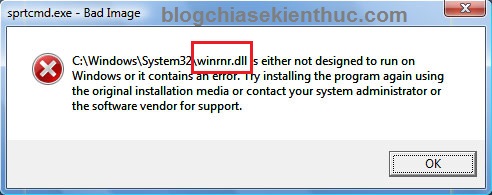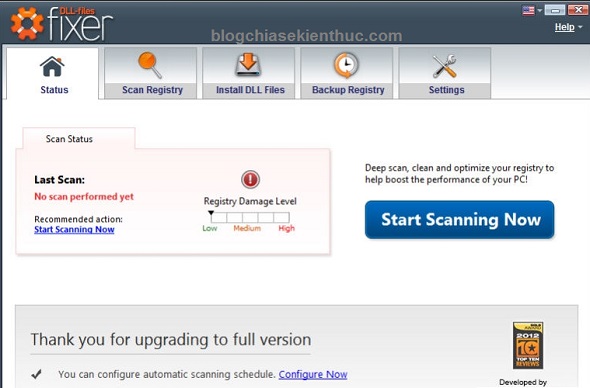Fix missing file * .dll manually and software Dll-files Fixer
Have you ever encountered a * .dll file missing error during software installation or game installation? If you are looking for a way to fix this annoying error, this is the article for you. This article I will guide you in detail how to download the * .dll files that the computer is missing and fix the most detailed and effective missing dll file error today.
But first we will briefly learn a bit about the concept of * .dll file format. I will tell you briefly, as easy as possible to imagine.
I. What is file * .dll? and how does it work?
DLL stands for Dynamic-Link Library. This is a library provided by Microsoft that contains structured files that programs or software may call it during use.
This makes sense in helping many different programs / software can share a single file and take advantage of its capabilities at the same time.
Windows .dll library helps the operating system to minimize file duplication, making it much cleaner. The DLL file contains classes, functions, variables, interfaces, and resources such as icons, images .
On all operating systems, you will encounter two types of libraries: the static library (lib) and the dynamic library (.dll).
While the static libraries are linked to the executable at compile time, the dynamic libraries are not. A dynamic library is a standalone file that can be updated individually without altering the * .exe executable.
II. Why is the .dll file missing on the computer?
Windows operating system stores a large number of * .dll files, so the frequency of using them is very high, so DLL-related errors are also very common.
The main directory where the .dll files are stored are C: WindowsSystem32 (for Windows 32bit operating system) and C: WindowsSysWOW64 (for Windows 64bit operating system). You can access that folder to view.
III. Some warnings about missing * .dll files are common
The key to dealing with this problem is that you need to read the error in the error message popup window. For example, in the picture below, the computer is reporting a missing file winrnr.dll error.

Error message file MSVCP71.dll is missing

Error message file WS2_32.dll missing

Error message file MSVCR71.dll missing

Above, we take a few examples of missing dll file errors, and countless other errors of missing dll files. To solve this .dll file missing error we have 2 ways that is to use the software and not to use the software. Here are the detailed instructions for you:
1. Fix the error of missing dll files without using the software
+ Step 1: Look at the error message popup and remember the name * .dll file that I am missing. For example, in the figure 1, I am missing the winrnr.dll file.
+ Step 2: Visit the website here.
+ Step 3: Enter the name of the .dll file in the search box => then press Enter to search.

+ Step 4: Click DOWNLOAD ZIP-FILE

Next, choose the version that matches the version of Windows that you are using to download (How to see if the computer is using win 32bit or 64bit).

+ Step 5: Extract the file you just downloaded (you can use Winrar to unzip). Then copy the extracted file to the Windows System folder. You copy the path corresponding to the system as follows:
32bit Windows version:
- Windows® 95/98/Me bạn copy vào thư mục System: C:WindowsSystem
- Windows NT/2000 bạn copy vào thư mục System32: C:WINNTSystem32
- Windows XP, Windows Vista, Windows 7/8/8.1 bạn copy vào thư mục System32 C:WindowsSystem32
64bit Windows version:
You copy the following path: C:WindowsSysWOW64
OK! Now, please reopen the program that failed to install and run again to see the results.
2. Using the software DLL-Files Fixer
Dll-files Fixer is a software provided by the website we have manually searched above which is dll-files
And of course to use this software, you will have to pay a fee for them. But in return, you will not need to search and install manually anymore, but all will be made from a to z by Dll-files Fixer software with just 1 click.

Some of the main advantages of Dll-files Fixer
- Fix missing dll file errors quickly and easily.
- Registry optimization and smart Registry defrag.
- Repair errors caused by the Registry.
- Increase the speed and performance of computer systems.
- Prevent and restrict applications and your computer from hanging during use.
You can download the trial version here .
3. Install additional Microsoft support applications
In addition to how to find the missing DLL file, you can refer to the following DLL file missing error correction books:
- The easiest way and also the way you should try to apply it first is to try to reinstall the software / program again.
- Try to use Windows Resource Protection Tool or System File Checker (SFC) to deal with missing system files.
- Update the Microsoft Visual C ++ Redistributable packages if Windows is missing.
- Install the Microsoft .NET Framework packages that are appropriate for the Windows operating system.
IV. Conclude
Those are the most effective and common ways to fix missing dll files today. And in my opinion, I recommend that you use the manual method better, not having to waste time installing.
Unless you cannot download it manually, please use the software at this time. Good luck!
You should read it
- How to fix errors cannot be found or missing .DLL files
- How to Repair Defective or Missing System Files in Windows
- What are DLL files? How does it work? Why is the DLL file missing?
- What is a DAT file? How to open DAT files, How to read DAT files on Windows and Macbook computers
- Access shared files on the network even when Offline
- What can the iOS 11 file manager application do?
- How to find the downloaded file on your Android device
- How to Unrar
May be interested
- Top software to extract files and compress files today
 the network administrator will present you the best file compression and file decompression software available today, you can consult before compressing files or extracting your data files.
the network administrator will present you the best file compression and file decompression software available today, you can consult before compressing files or extracting your data files. - How to fix missing Windows 11 update files error
 this windows 11 update missing file error usually appears with error codes like 0x80073712 or 0x8007000d. here are some ways to fix the windows 11 update missing file error.
this windows 11 update missing file error usually appears with error codes like 0x80073712 or 0x8007000d. here are some ways to fix the windows 11 update missing file error. - How to fix missing file gdi32full.dll on Windows 10, 11
 fixing the missing file gdi32full.dll on windows 10, 11 will help windows 10, 11 work more stably. error missing file gdi32full.dll on windows 10, 11 will prevent you from opening applications on your computer.
fixing the missing file gdi32full.dll on windows 10, 11 will help windows 10, 11 work more stably. error missing file gdi32full.dll on windows 10, 11 will prevent you from opening applications on your computer. - How to fix errors cannot be found or missing .DLL files
 dll errors are especially troublesome because there are many types of files like this that exist, all of which pose the potential for errors. fortunately, there are several troubleshooting steps you can take to fix any dll errors.
dll errors are especially troublesome because there are many types of files like this that exist, all of which pose the potential for errors. fortunately, there are several troubleshooting steps you can take to fix any dll errors. - How to fix missing vcruntime140.dll file in Windows
 how to fix missing vcruntime140.dll file in windows. dll (dynamic link library) is a very important file format in a computer system, application, it is the core file for the program to run completely.
how to fix missing vcruntime140.dll file in windows. dll (dynamic link library) is a very important file format in a computer system, application, it is the core file for the program to run completely. - How to fix Winload.efi is missing on Windows
 winload.efi is the executable file for the computer's firmware mainly based on uefi and executes file downloading tasks into the bootloader of the computer. this article will show you how to fix winload.efi error is missing on windows.
winload.efi is the executable file for the computer's firmware mainly based on uefi and executes file downloading tasks into the bootloader of the computer. this article will show you how to fix winload.efi error is missing on windows. - How to fix an error that cannot be found or missing D3dx9_43.dll file
 d3dx9_43.dll error occurs when microsoft directx has problems. the d3dx9_43.dll file is one of many files contained in directx software. because windows-based games and advanced graphics programs use directx, the d3dx9_43 dll error only appears when using these programs.
d3dx9_43.dll error occurs when microsoft directx has problems. the d3dx9_43.dll file is one of many files contained in directx software. because windows-based games and advanced graphics programs use directx, the d3dx9_43 dll error only appears when using these programs. - How to reduce PDF file size by software
 reducing the size of pdf files will make file sharing much more convenient, the file size is significantly reduced while the quality of file content remains the same.
reducing the size of pdf files will make file sharing much more convenient, the file size is significantly reduced while the quality of file content remains the same. - 3 software that shows hidden files in USB should not be ignored
 when a virus enters the usb, it happens that the files in the card will disappear and be hidden. therefore, users will need software that supports hidden files in usb.
when a virus enters the usb, it happens that the files in the card will disappear and be hidden. therefore, users will need software that supports hidden files in usb. - What is the error Msvcr110.dll missing? How to prepare?
 the dll (dynamic link library) error is very annoying and can appear even if you have the mentioned missing file on your computer. one such error is msvcr110.dll missing which appears when launching the program.
the dll (dynamic link library) error is very annoying and can appear even if you have the mentioned missing file on your computer. one such error is msvcr110.dll missing which appears when launching the program.










 How to fix Webcam error on Windows 10
How to fix Webcam error on Windows 10 3 ways to disable applications that are hanging on windows computers
3 ways to disable applications that are hanging on windows computers 3 ways to fix error 0x80040c97 OneDrive couldn't be installed
3 ways to fix error 0x80040c97 OneDrive couldn't be installed How to fix a laggy computer
How to fix a laggy computer How to fix a sideways computer screen
How to fix a sideways computer screen